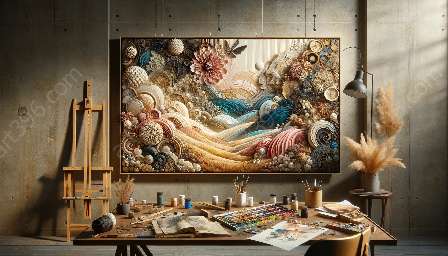Contemporary artists are continuously exploring alternative exhibition spaces and formats to showcase their mixed media art in unique and impactful ways. By breaking away from traditional gallery settings, mixed media artists are embracing a range of non-traditional spaces and presentation formats to engage audiences and push the boundaries of art experiences.
The Influence of Contemporary Mixed Media Art
Contemporary mixed media art is characterized by its innovative use of materials, techniques, and visual elements. Artists working in this genre often combine various mediums, such as photography, painting, collage, and found objects, to create multi-dimensional artworks that defy categorization. The fluid and experimental nature of mixed media art makes it particularly well-suited for unconventional display methods and non-traditional exhibition spaces.
Non-Traditional Exhibition Spaces
One of the key trends in contemporary mixed media art is the utilization of non-traditional exhibition spaces. Instead of confining their work to traditional white-walled galleries, artists are seeking out alternative venues that offer a fresh and dynamic context for their art. These spaces may include abandoned buildings, outdoor environments, public parks, industrial warehouses, and even virtual platforms in the digital realm. By harnessing the unique attributes of these spaces, artists can create immersive and site-specific experiences for viewers, blurring the lines between art and the surrounding environment.
Pop-up Exhibitions
Pop-up exhibitions have emerged as a popular format for showcasing mixed media art in unexpected locations. These temporary events, often organized independently by artists or collectives, can take place in unconventional settings, such as temporary structures, public transit stations, or even moving vehicles. The ephemeral nature of pop-up exhibitions adds an element of surprise and spontaneity to the viewing experience, inviting audiences to engage with art outside of traditional gallery settings.
Interactive Installations
Interactive installations have become a staple of contemporary mixed media art, and they often require non-traditional exhibition formats to fully engage viewers. By encouraging physical interaction, viewer participation, and multi-sensory experiences, these installations break away from the passive viewing experience associated with conventional art displays. Alternative exhibition spaces, including public plazas, outdoor landscapes, and unconventional indoor environments, provide the ideal backdrop for interactive installations that invite audiences to become active participants in the art-making process.
The Evolution of Exhibition Formats in Mixed Media Art
As the field of mixed media art continues to evolve, artists are redefining the traditional exhibition format to reflect the dynamic and experimental nature of their work. The rise of digital platforms and virtual spaces has opened up new possibilities for showcasing mixed media art in ways that transcend the physical limitations of traditional galleries. Virtual exhibitions, online galleries, and multimedia presentations allow artists to reach global audiences and experiment with new modes of presentation that challenge the boundaries of conventional art display.
Outdoor Sculpture Parks and Installations
Outdoor sculpture parks and installations provide mixed media artists with expansive and unconventional exhibition spaces that offer a direct dialogue with the natural environment. By integrating their artworks within outdoor landscapes, artists can create large-scale installations that interact with the elements and evolve over time. These immersive experiences invite viewers to engage with art in a way that transcends the confined spaces of traditional galleries, fostering a deeper connection between art and nature.
Collaborative Exhibitions
Collaborative exhibitions have become increasingly prevalent in the realm of mixed media art, with artists joining forces to create multi-disciplinary shows that challenge the traditional model of solo displays. These collaborative ventures often seek out alternative exhibition spaces that accommodate diverse art forms, such as performance art, sound installations, and digital media, blurring the boundaries between different creative disciplines. By breaking down traditional hierarchies of art presentation, collaborative exhibitions open up new possibilities for engaging with mixed media art in a non-linear and interactive context.
Conclusion
Alternative exhibition spaces and formats play a pivotal role in shaping the contemporary landscape of mixed media art. By embracing non-traditional settings and presentation styles, artists are redefining the ways in which art is experienced and consumed. The dynamism and experimental spirit of mixed media art are perfectly suited to thrive in alternative exhibition spaces, offering audiences diverse and immersive encounters that challenge preconceived notions of art display. As the boundaries of mixed media art continue to expand, the exploration of alternative exhibition spaces and formats will undoubtedly remain a driving force in shaping the future of this vibrant and ever-evolving artistic genre.

